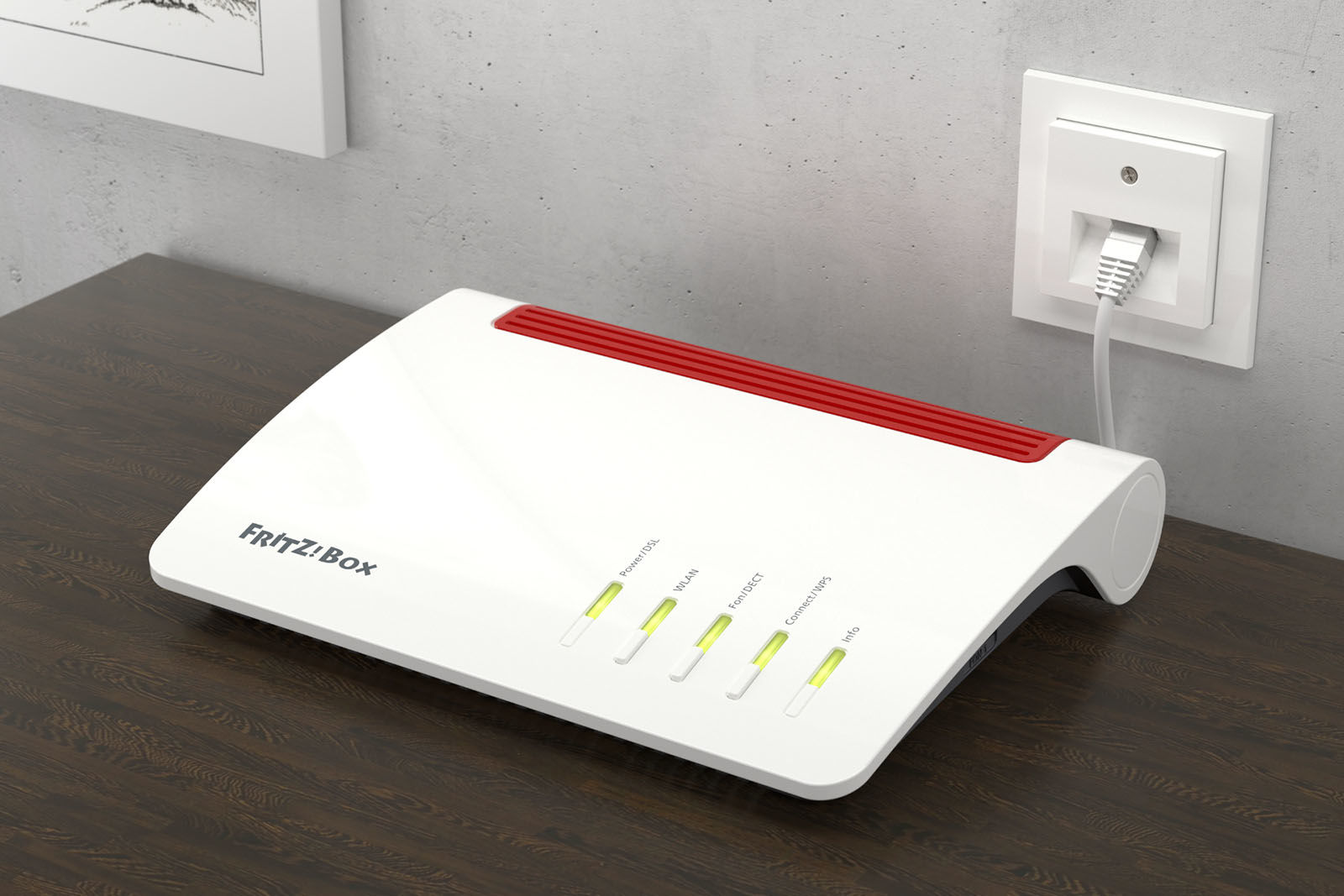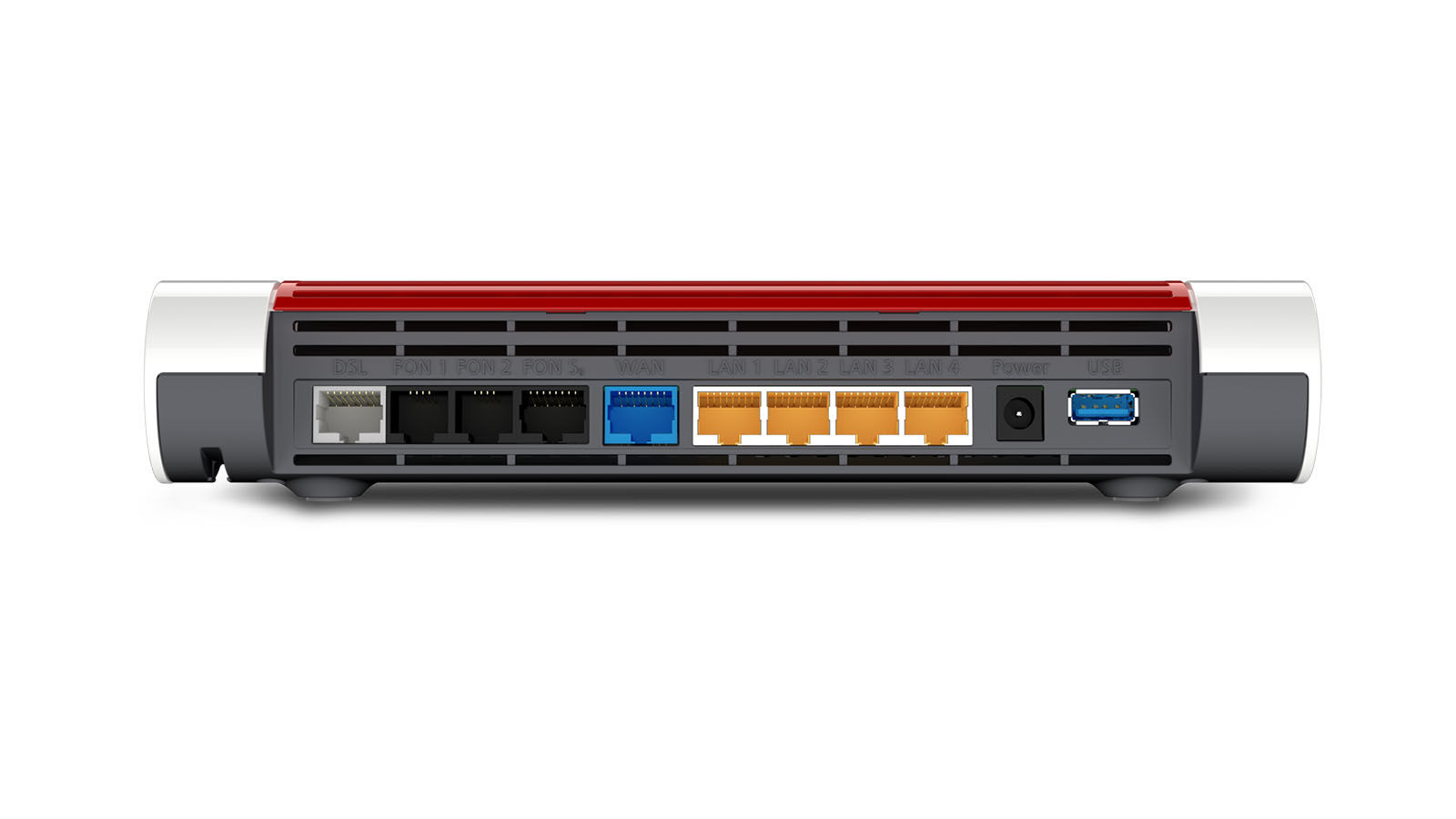That model costs £135, but the new flagship FRITZ!Box 7590 costs more than twice as much. Once you start delving into the specifications the reason for the price difference becomes obvious, as it includes features not commonly found on routers that are aimed at consumers. Really, this is a flagship router aimed at gadget enthusiasts that love playing with features.
FRITZ!Box 7590: Price
If you simply can’t wait, there’s an international version (part code: 20002804) that simply comes with non-UK cables. If you’re not interested in the 35b super vectoring, ISDN or analogue phone support, you could opt for the £190 FRITZ!Box 7560, though it uses the older case design.
FRITZ!Box 7590: Features and Design
For many people, this writer included, the prior FRITZ!Box models styling was a little too ‘Jetsons’ for comfort. While retaining some retro styling, these elements have been toned down to deliver something that still looks dynamic but never strays from a solid core of practicality.
The aerofoil shape and projecting feet lift the underside of the case away from any surface, allowing good airflow to the slotted vents on the underside. It can be wall mounted, with all the majority of ports presented on the top side in that arrangement. On the rear are five LAN gigabit ports, one being pre-allocated to the WLAN connection. This port covers cable modems, with a proper DSL input alongside for connecting those using a VDSL or ADSL line.
That’s all rather normal for a high-end router, but the FRITZ!Box 7590 has ports that few people will have seen on a router outside of specialist equipment inventory. Radically AVM has included an IDSN S bus port, for those people still using that technology, and there are also a couple of analogue telephone ports that you could use with a Fax. We’re unsure if encouraging the continued existence of old analogue technologies is a good thing or not, but AVM decided to support those who still use them. The unit also sports two USB 3.0 ports for the limited NAS functionality that most routers seem to offer these days. These ports can also be used to connect 3G and 4G dongles to create a fall-back internet access, or for use in locations with no landline. If you thought the outside was marginally idiosyncratic, it’s little preparation for what AVM put on the inside. Of these the most interesting is undoubtedly the modem, and its advanced capabilities. The latest development in VDSL (BT Infinity, etc.) is a technology called VDSL 35b super vectoring (also called VDSL Annex Q, Vectoring, and V Plus) that in theory allows copper twisted pairs to support speeds of up to 300 Mbit/s over distances of less than 300m. How this works, by generating counter-interference, is a subject worthy of another article, but simplistically it can provide faster links for single customers and also more people on the same line while achieving greater overall performance. The only snag for UK broadband customers is that at this time VDSL 35b hasn’t been adopted by any providers at this time, so it’s only future-proofing for a possible future. Whatever service the box is ultimately connected, the majority of devices will be accessing it via WiFi. Despite having no external antenna, the 7590 still offers 4 x 4 Multi-User MIMO with a bandwidth of 1733 Mbit/s on the 5-GHz frequency. And, another 800 Mbit/s of theoretical bandwidth is available from the 2.4-GHz range, for older devices.
FRITZ!Box 7590: Even more features
Fritz!OS 7
This new software update brings yet more features. Chief among these is support for mesh networking. Yep, that’s right: you don’t need to buy a dedicated mesh Wi-Fi system as you can use the 7590 plus the Fritz!box 4040 and 7490 to form a mesh network and get great Wi-Fi coverage around your home. AVM Mesh supports 11v and 11k standards, so as long as your Wi-Fi devices also support one, they will be ‘steered’ to the best access point as you move around. You can read more details on this major update.
DECT
Another addition on the things-we’ve-not-seen-before list is DECT phone support. This router will inherently act as a DECT base station and supports up to six DECT phones. The full beauty of this functionality only becomes apparent when you appreciate how AVM connected this feature into the routers OS, and also made it accessible remotely. That allows both inbound and outbound calling rules to be applied, diversions applied, and the router will even act as voicemail system. This review only scratches the surface of what you can do with this solution, as it empowers the home user with many features and facilities that have traditionally been the scope of business telephone systems. A capability that we especially liked was that by using the FRITZ!App Fon application (iPhone and Android) it is possible to make a call from a mobile handset that originates through the landline, using whatever call deals you have on that service. It can also alert you if the home phone rings, and even access the answerphone remotely to listen to any messages the caller left.
There are five other FRITZ! Phone apps that enable you to remotely access home located media, security cameras, network monitoring, remotely configure the router and even watch TV if you’ve a FRITZ!WLAN Repeater DVB-C. Therefore, calling the FRITZ!Box 7590 a ‘router’ misses the scope and flexibility of this solution, as it manages analogue telecoms as elegantly as digital services.
Performance
From the outset, we need to state that as no VDSL 35b services are available in the UK. Therefore, we couldn’t test that part of the 7590’s repertoire. As a wireless router, the 7590 is a solid performer but not exceptional. Typical close quarters connections over 5GHz hit transfer speeds of 52Mb/s, and extending this range dropped that number to 12Mb/s once a wall or two got in the way. The lack of external antenna seemed to have little impact on the potential range and removed the temptation to play with the positioning of them.
The only true performance disappointment was in respect of the two USB 3.0 ports. They managed just 21MB/s writing and 32MB/s reading from a high-speed USB flash memory module. While this isn’t abysmal, it’s well below what the port is technically capable of achieving, and not that much better than USB 2.0 can do. This issue isn’t unique to the FRITZ!Box 7590, as many routers are constructed around ARM-based SoC’s that include the connectivity of USB 3.0 without actually delivering the internal bandwidth to operate them fully.
Should I buy a FRITZ!Box 7590?
There are so many things to like about this router. For starters, it doesn’t look like a spider from Mars or a diminutive Batmobile. But the real strength of this design is the original thinking that’s gone into every aspect of it. Many people have DECT phones at home, and the 7590 evates them to a whole new level of usefulness. When you combine those aspects with the remote control apps and media management features the FRITZ!Box 7590 becomes significantly more than the sum of its parts. As you begin to use it, you notice the little details such as the automatically dimming lights, and the advanced power management, and email notifications. AVM also makes a collection of support devices, like the FRITZ!WLAN Repeaters and FRITZ!Powerline plus. These are designed to work with the router to provide a mesh of network coverage that allows wireless devices to seamlessly move between signals using the same SSID without service interruptions. The term ‘feature rich’ doesn’t do this hardware justice. This is all great if you want and will use those features. Landlines in the UK have already slipped into disuse for a lot of people, while VDSL 35b isn’t yet ready to be exploited, leaving that functionality kicking its heels while the wheels of digital communication grind on at a glacial pace. If you can accept VDSL 35b may be a pipedream and can handle the cost now, the AVM FRITZ!Box 7590 is a smart choice. But if you’ll only use a fraction of its feature set, you can find better-performing 802.11ac routers for less money elsewhere. Mark is an expert on displays, reviewing monitors and TVs. He also covers storage including SSDs, NAS drives and portable hard drives. He started writing in 1986 and had contributed to MicroMart, PC Format, 3D World among others.



